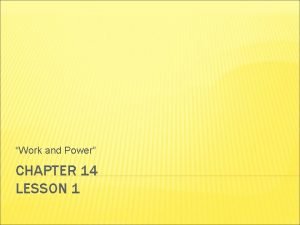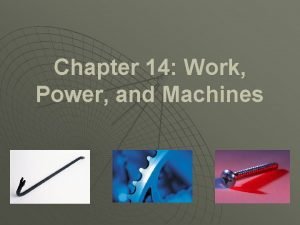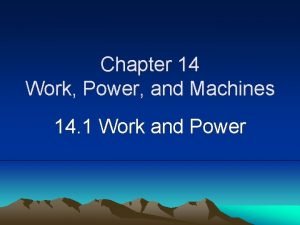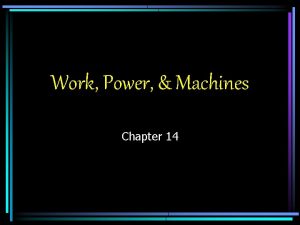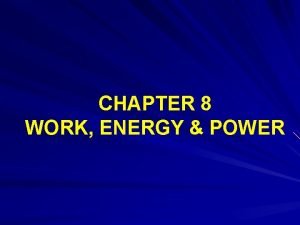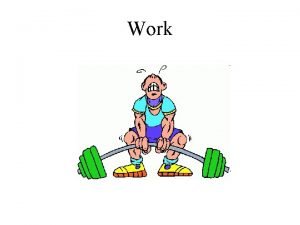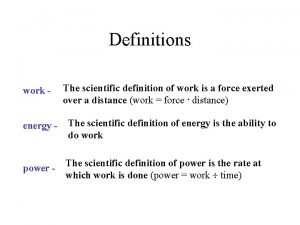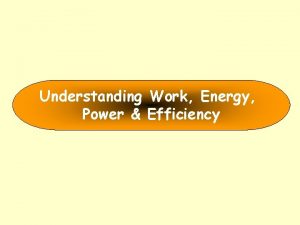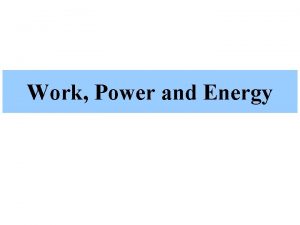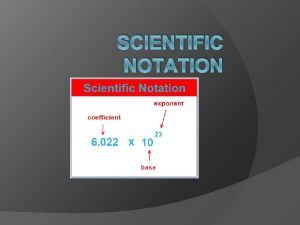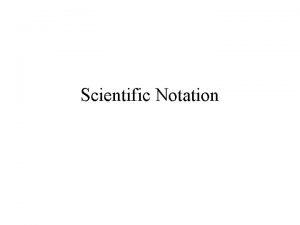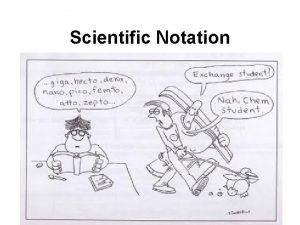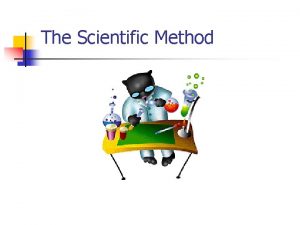CHAPTER 11 Work and Power WORK In scientific


















- Slides: 18

CHAPTER 11 Work and Power

WORK • In scientific terms, you do work any time you exert a force on an object that causes the object to move some distance. • If the object does not move, no work is done, no matter how much force is exerted.

CALCULATING WORK • Work = force x distance • Work is measured in joules.

POWER • Power is the rate at which work is done. • Power equals the amount of work done on an object in a unit of time. • SI unit for power is the watt(W)

MACHINES • Machines are devices that allow you to do work in an easier way. • Machines do not reduce the amount of work you do. Instead they just change the way you do work.

MAKING WORK EASIER WITH MACHINES • A machine makes work easier by changing at least one of three factors: • The amount of force you exert • The distance over which you exert your force • The direction in which you exert your force

INPUT VS OUTPUT • Input- force you exert when you do work • Output- weight of an object over distance

MECHANICAL ADVANTAGE • Mechanical advantage is the number of times a machine increases a force exerted on it. The ratio of output force to input force is the mechanical advantage of a machine.

INCLINED PLANES AND LEVERS • A simple machine is the most basic device for making work easier. • Three closely related simple machines- the inclined plane, the wedge, and the screw- form the inclined plane family.

INCLINED PLANE • An inclined plane is a flat, sloped surface. • Lifting a heavy object such as a motorbike is much easier with a ramp. • An inclined plane allows you to exert your input force over a longer distance. • As a result, the input force needed is less than the output force.

WEDGE • A wedge is a device that is thick at one end and tapers to a thin edge at the other end. • When you use a wedge, instead of moving an object along the inclined plane, you move the inclined plane itself. • An ax is an example of a wedge.

THE SCREW • Like a wedge, a screw is a simple machine that is related to the inclined plane. A screw can be thought of as an inclined plane wrapped around a cylinder. • The threads of a screw act like an inclined plane to increase the distance over which you exert the input force. • Examples of screws are bolts, drills, and jar lids.

LEVER • Have you ever ridden on a seesaw or used a spoon to eat your food? • If so, you have used a lever. • A lever is a rigid bar that is free to pivot, or rotate, on a fixed point. The fixed point that a lever pivots around is called the fulcrum.

1 ST, 2 ND, AND 3 RD CLASS LEVERS 3 rd class lever

PULLEY • Two simple machines take advantage of turning : the pulley and the wheel and axle.

HOW A PULLEY WORKS? • A pulley is a simple machine made of a grooved wheel with a rope or cable wrapped around it. You use a pulley by pulling on one end of the rope. This is the input force. At the other end of the rope, the output force pulls up on the object you want to move. The grooved wheel turns. This makes it easier to move the rope than if it had just been looped over a stick.

HOW A WHEEL AND AXLE WORKS? • A simple machine made of two connected objects that rotate about a common axis is called a wheel and axle. • Examples are screwdrivers, paddle boats, and door knobs

COMPOUND MACHINES • A machine that combines two or more simple machines is called a compound machine. • Within a compound machine, the output force of one simple machine becomes the input force of another simple machine.
 The real lesson 21
The real lesson 21 Scientific inquiry vs scientific method
Scientific inquiry vs scientific method How is a scientific law different from a scientific theory?
How is a scientific law different from a scientific theory? Section 4 review physical science
Section 4 review physical science Chapter 14 section 1 work and power
Chapter 14 section 1 work and power Chapter 14 work power and machines
Chapter 14 work power and machines Chapter 14 section 1 work and power
Chapter 14 section 1 work and power Chapter 14 work power and machines
Chapter 14 work power and machines Chapter 8 work and power answers
Chapter 8 work and power answers Solar power satellites and microwave power transmission
Solar power satellites and microwave power transmission Actual power
Actual power The dispersive power of grating is
The dispersive power of grating is Scientific meaning of work
Scientific meaning of work How does the scientific method work
How does the scientific method work Definition of work
Definition of work Work power and efficiency
Work power and efficiency Define work and power
Define work and power Definition of work in physics
Definition of work in physics How to calculate work and power
How to calculate work and power




